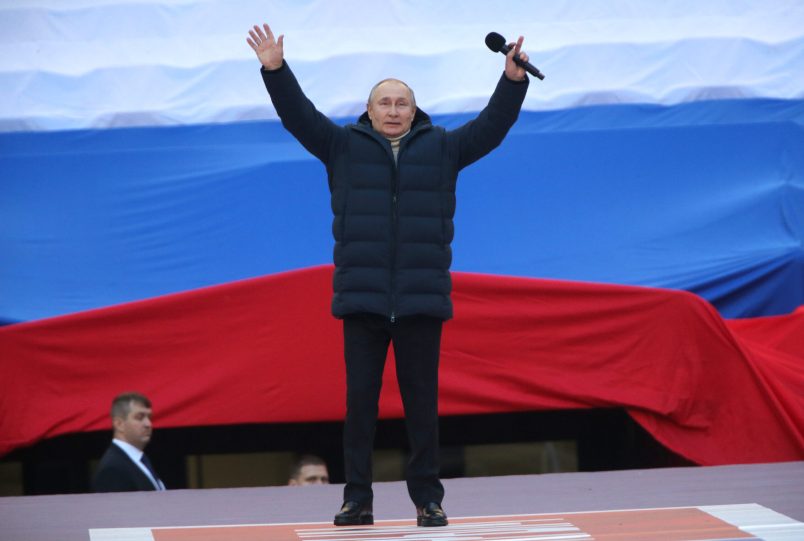A few miscellaneous Ukraine notes.
The White House just announced that President Biden has approved the transfer of another $800 million in arms and security assistance to Ukraine, including ammunition, armored personal carriers and helicopters. This comes just after a call today between Presidents Biden and Zelensky. This is part of a more general move toward providing Ukraine not just defensive weaponry — light/mobile anti-tank and anti-aircraft weaponry — but heavier weaponry required for offensive operations. It’s also best to see these moves in the context of actions taken by all NATO member states since they are all coordinated.
If you haven’t been watching the latest developments closely there’s been a key evolution over the last couple weeks. Russia has withdrawn troops not only from the area around Kyiv but from various theaters which were part of its original, more ambitious plan to topple the Ukrainian government and occupy the country. Those forces, or those that remain capable of fighting, are being redeployed in the Donbas region in the east. This is area where Russia set up its puppet separatist statelets in 2014. So Russia is shifting toward much more limited goals but ones that it is or should be more able to achieve. These are regions right on the border with Russia. Russia’s forces will now be more concentrated and easier to resupply. These areas at least have more pro-Russian sentiment than the rest of Ukraine — though how much is not clear given the events of the last six weeks. At the moment a race is on for both sides to redeploy for this new, more concentrated battle and get there first with the most.
Over the last couple weeks military analysts have spoken extensively about a window of opportunity Ukraine has to deal Russia a decisive blow in the east while the Russians are still moving their forces into position, resupplying and reequipping battered units that were mauled in the failed effort to conquer Kyiv and other parts of the country. One aspect of surrounding another country is that you have to travel further outside the country to move your forces around than they do on the inside. Of course, the Ukrainians have been through intense fighting. They’ve lost soldiers. They’ve lost hardware. You have two armies that have both been bloodied pretty badly racing to get into position for the next phase of the war.
A key question is Ukraine’s offensive capacity. Much of Ukraine’s success so far has been disrupting the Russian conquest. So using anti-tank and anti-aircraft weaponry to block Russian offensives. In the east though Russia largely occupies this territory. The Russians seem to want to expand and consolidate their hold in the east. Ukraine needs to reconquer territory they don’t currently hold. That’s a bigger challenge and it requires different military hardware. So much of the debate now over arming Ukraine and the kinds of weaponry the U.S. and other NATO allies are willing to provide is tied to that question: what kinds of weaponry are necessary to make it possible for the Ukrainians to reconquer territory?
You may be thinking, well, they’ve already been taking back territory. And that’s true. But there are some key differences. Much of the territory Ukraine has taken back over the last couple weeks is territory Russia was withdrawing from. They were withdrawing because a combination of poor logistics and Ukrainian counteroffensives made it untenable for them to stay. But in many of these areas the Russians decided to retreat. That’s much less likely in the the Donbas region. Russia will be able to concentrate its forces and just as importantly they will have Russian territory at their backs. So their ability to resupply their forces should be much greater.
Final point — and this is more a reportorial observation than a substantive one. But it’s notable nonetheless. Ukraine has totally dominated the information war from the beginning. Russia also mobilized big armored formations which are inherently easier to see. So we see lots of destroyed Russian tanks and satellite views of Russian positions and so forth. But if you watch news coverage you don’t “see” the Ukrainian Army a lot. You see individual soldiers in social media videos and stuff. But you get much less of a sense of quite literally what the Ukrainian Army is made of — how much armor it has, how many planes it’s flying, the scale of its offensives.
Trained analysts and people with access to intelligence certainly know a lot more. I’m not saying no one knows these things. But what you pick up in news coverage is overwhelmingly about the Russian Army. Ukraine’s armed forces are paradoxically hard to see clearly, both literally and figuratively. That artifact of press coverage and information warfare is worth thinking about as we try to get a sense as observers as to just what is going on.






